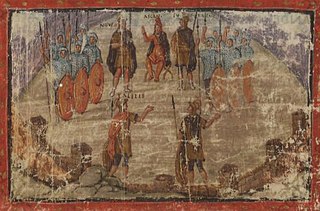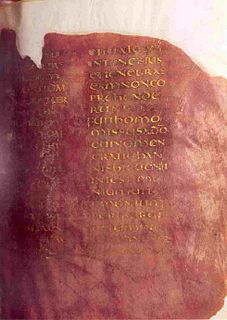 W
WThe Ambrosian Iliad or Ilias Picta is a 5th-century illuminated manuscript on vellum, which depicts the entirety of Homer's Iliad, including battle scenes and noble scenes. It is considered unique due to being the only set of ancient illustrations that depict scenes from the Iliad. The Ambrosian Iliad consists of 52 miniatures, each labeled numerically, created in Alexandria, given the flattened and angular Hellenistic figures, which is considered typical of Alexandrian art in the Late Antiquity period, in approximately 500 AD, possibly by multiple artists. The author(s) first drew the figures nude and then painted the clothes on, much like in Greek vase painting. In the 11th century, the miniatures were cut out of the original manuscript and pasted into a Siculo-Calabrian codex of Homeric texts.
 W
WCodex Glazier, designated by siglum copG67, is a Coptic uncial manuscript of the New Testament on parchment. It is dated palaeographically to the 4th or 5th century. Textually it is very close to Greek Codex Bezae.
 W
WThe Cotton Genesis is a 4th- or 5th-century Greek Illuminated manuscript copy of the Book of Genesis. It was a luxury manuscript with many miniatures. It is one of the oldest illustrated biblical codices to survive to the modern period. Most of the manuscript was destroyed in the Cotton library fire in 1731, leaving only eighteen charred, shrunken scraps of vellum. From the remnants, the manuscript appears to have been more than 440 pages with approximately 340-360 illustrations that were framed and inserted into the text column. Many miniatures were also copied in the 17th century and are now in the Bibliothèque nationale de France in Paris.
 W
WThe Johnson Papyrus is a fragment of an early 5th century AD herbal. It is the oldest extant manuscript illustration of a plant. The papyrus fragment shows a sphere of dark blue-green leaves supported by some small scraggly roots. Below the illustration is a fragment of Greek text. The illustrated plant has been identified as "symphyton", which was an important medicinal plant. However the illustration does not closely resemble comfrey, so that, if the identification is correct, the illustration would have had been of little use as an aid to identification.
 W
WNaples, Biblioteca Vittorio Emanuele III, MS I B 18 is a fragment of 5th century manuscript of the Old Testament written in uncials in the Sahidic dialect of the Coptic language. The manuscript has only 8 surviving folios and includes the text from Job 40:8 to Proverbs 3:19.
 W
WThe Quedlinburg Itala fragment is a fragment of six folios from a large 5th-century illuminated manuscript of an Old Latin Itala translation of parts of 1 Samuel of the Old Testament. It was probably produced in Rome in the 420s or 430s. It is the oldest surviving illustrated biblical manuscript and has been in the Berlin State Library since 1875-76. The pages are approximately 305 x 205 mm large.
 W
WThe Vergilius Romanus, also known as the Roman Vergil, is a 5th-century illustrated manuscript of the works of Virgil. It contains the Aeneid, the Georgics, and some of the Eclogues. It is one of the oldest and most important Vergilian manuscripts. It is 332 by 323 mm with 309 vellum folios. It was written in rustic capitals with 18 lines per page.
 W
WThe Vergilius Vaticanus, also known as Vatican Virgil, is a Late Antique illuminated manuscript containing fragments of Virgil's Aeneid and Georgics. It was made in Rome in around 400 C.E., and is one of the oldest surviving sources for the text of the Aeneid. It is the oldest and one of only three ancient illustrated manuscripts of classical literature.
 W
WThe Codex Veronensis, designated by siglum b or 4, is 5th century Latin Gospel Book. The text, written on purple dyed vellum in silver and occasionally gold ink, is a version of the old Latin. The Gospels follow in the Western order.